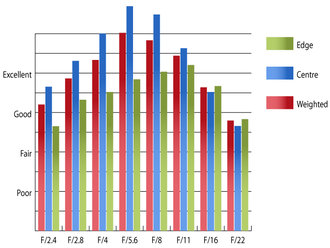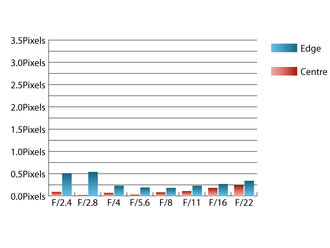Pentax HD PENTAX-DA 70mm f/2.4 Limited Lens Review
HD PENTAX-DA 70mm f/2.4 Limited Performance
This lens puts in an excellent performance as far as sharpness is concerned. At maximum aperture, sharpness in the centre of the frame is already very good, although the clarity recorded towards the edges of the frame is only fairly good at this aperture. Stopping down improves performance across the frame, with peak sharpness across the frame being achieved between f/5.6 and f/8. Here sharpness in the centre is outstanding, whilst clarity towards the edges of the frame is excellent here.  MTF @ 70mm | How to read our chartsThe blue column represents readings from the centre of the picture frame at the various apertures and the green is from the edges. Averaging them out gives the red weighted column.The scale on the left side is an indication of actual image resolution. The taller the column, the better the lens performance. Simple. For this review, the lens was tested on a Pentax K-5 IIs using Imatest. |
Chromatic aberrations are extremely well controlled, with levels of fringing only just reaching half a pixel width between f/2.4 and f/2.8 towards the edges of the frame. Stopping down to f/4 or beyond reduces fringing to very low levels, which should be very hard to spot, even if you're looking closely for it.
 CA @ 70mm | How to read our chartsChromatic aberration is the lens' inability to focus on the sensor or film all colours of visible light at the same point. Severe chromatic aberration gives a noticeable fringing or a halo effect around sharp edges within the picture. It can be cured in software.Apochromatic lenses have special lens elements (aspheric, extra-low dispersion etc) to minimize the problem, hence they usually cost more. For this review, the lens was tested on a Pentax K-5 IIs using Imatest. |
Falloff of illumination is well controlled for a lens with a maximum aperture of f/2.4. At f/2.4 the corners of the frame are 1.08 stops darker than the image centre and visually uniform illumination is achieved with the lens stopped down to f/5.6 or beyond.
Distortion is also very well controlled. Imatest could only detect 0.35% pincushion distortion, which isn't much at all and will be difficult to spot.
This lens is very resistant to flare and contrast levels remain good when shooting into the light thanks to the HD coating applied to optical surfaces. A circular hood is supplied, which screws into the 49mm filter thread. The hood has an extendable front section, which can simply be pulled out when more shade is required.
Add your message
Login required
Please login here or if you've not registered, you can register here. Registering is safe, quick and free.
Please login here or if you've not registered, you can register here. Registering is safe, quick and free.
photodo Stats
1102 lenses
428 MTF tests
74 in-depth photodo reviews
100+ users join each day
Help the lens community by reviewing or rating a lens today via our lens search
428 MTF tests
74 in-depth photodo reviews
100+ users join each day
Help the lens community by reviewing or rating a lens today via our lens search
Latest Lens Reviews
- Chinon 28mm f/2.8 Vintage Lens Review
- Canon EF 70-200mm f/4L IS II USM Lens Review
- Samyang AF 85mm f/1.4 EF Review
- Sigma 70mm f/2.8 DG Macro Art Review
- Samyang AF 24mm f/2.8 FE Review
- Meike 50mm f/1.7 Review
- Tamron 70-210mm f/4 Di VC USD Review
- Lensbaby Burnside 35mm f/2.8 Review
- Asahi Super Takumar 50mm f/1.4 Review
- Asahi Super-Multi-Coated Takumar 135mm f/3.5 Review
